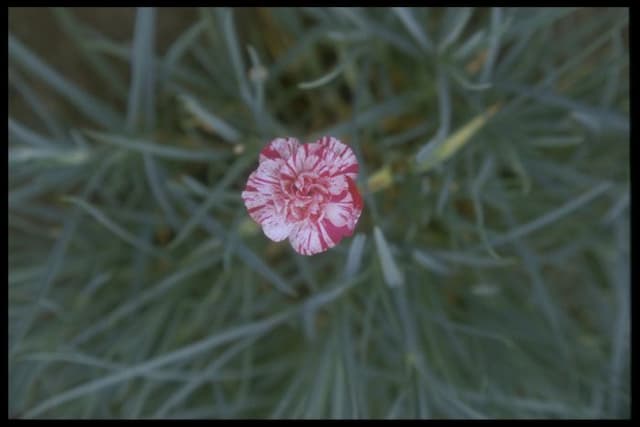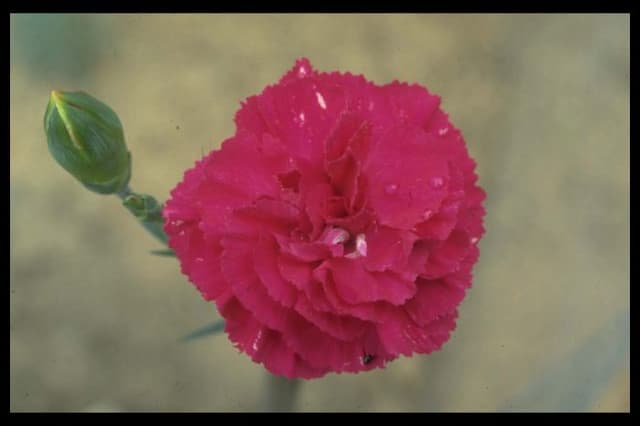Sweet William Dianthus 'Valda Wyatt' (p)

ABOUT
Dianthus 'Valda Wyatt' is a striking and vibrant flowering plant known for its beautiful blooms. The flowers are the highlight of this plant, boasting a rich pink color that can range in hue from soft to bright. Each flower typically consists of five petals, which often have a frilled or serrated edge, giving them a unique and decorative appearance that resembles a fanciful, ruffled texture. The petals may exhibit a patterned look with subtle variations in color intensity, often presenting a deeper or paler pink towards the center, sometimes with a circular eye of a contrasting hue in the middle. The blooms emit a delightful fragrance, enchanting to many who pass by, with a spicy or clove-like scent that can fill the surrounding air and attract pollinators such as bees and butterflies. The foliage of Dianthus 'Valda Wyatt' consists of narrow, linear leaves that are a grayish-green to blue-green color, which creates a lovely backdrop to the showy flowers. The leaves are typically slim and may have a slightly glaucous or waxy coating, which helps in retaining water and adds a silvery effect to the plant's overall appearance. The plant forms a neat, compact mound, which adds to its ornamental appeal, making it popular in garden borders, rockeries, or as a focal point in container plantings. The lush foliage and abundant flowers come together to create a charming and colorful display, making Dianthus 'Valda Wyatt' a favorite among garden enthusiasts who wish to add a touch of elegance and aromatic allure to their garden spaces.
About this plant
 Names
NamesFamily
Caryophyllaceae
Synonyms
Garden Pink, Cheddar Pink, Clove Pink
Common names
Dianthus 'Valda Wyatt'
 Toxicity
ToxicityTo humans
The plant commonly known as "pinks" is generally considered non-toxic to humans. There are no well-documented cases of poisoning from Dianthus 'Valda Wyatt'. Therefore, ingesting this plant is not expected to cause any significant symptoms of poisoning or adverse health consequences.
To pets
Dianthus 'Valda Wyatt', commonly known as "pinks", is not known to be toxic to pets. This means that ingestion of this plant should not result in poisoning or serious health issues for animals such as dogs and cats. However, as with any non-food item, consumption of large quantities might cause mild gastrointestinal upset due to the unfamiliar material, but no specific toxic effects are expected.
 Characteristics
CharacteristicsLife cycle
Perennials
Foliage type
Evergreen
Color of leaves
Blue-green
Flower color
Pink
Height
1 foot (30 cm)
Spread
1 foot (30 cm)
Plant type
Herb
Hardiness zones
5
Native area
Europe
Benefits
 General Benefits
General Benefits- Attractive Flowers: Dianthus 'Valda Wyatt', commonly known as pinks, produces brightly colored blooms that add aesthetic appeal to gardens and landscapes.
- Long Blooming Season: Pinks have a lengthy blooming period, which ensures colorful displays for extended periods, often from late spring to early fall.
- Easy Maintenance: This variety of pinks is known for being low-maintenance, requiring minimal care once established.
- Drought Tolerance: Pinks are relatively drought-tolerant, making them suitable for gardens in drier climates or where water conservation is a priority.
- Fragrance: The flowers of Dianthus 'Valda Wyatt' are often fragrant, adding a pleasant scent to the area where they are planted.
- Attracts Pollinators: The blooms attract bees and butterflies, supporting pollinator populations and promoting biodiversity.
- Versatility: Pinks can be used in various garden settings, including borders, rock gardens, and containers, offering flexibility in landscaping design.
- Deer Resistance: Pinks are known to be resistant to deer, making them a good choice for gardens in areas with high deer populations.
 Medical Properties
Medical PropertiesThis plant is not used for medical purposes.
 Air-purifying Qualities
Air-purifying QualitiesThis plant is not specifically known for air purifying qualities.
 Other Uses
Other Uses- Culinary Garnish: The edible petals of the Dianthus 'Valda Wyatt' can be used to add color and a slight spicy flavor to salads and desserts.
- Natural Fabric Dye: The flowers of the Dianthus 'Valda Wyatt', when boiled, can yield a range of pink and red hues, suitable for dyeing fabrics.
- Companion Planting: These plants can be grown alongside vegetables like tomatoes to entice pollinators and enhance biodiversity in the garden.
- Craft Projects: The dried petals can be used in making potpourri, sachets, or incorporated into paper making for added texture and visual appeal.
- Ice Cubes Decoration: Freeze Dianthus 'Valda Wyatt' flowers in ice cubes to create an attractive and edible addition for summer drinks and cocktails.
- Plant Markers: Dried stems of the Dianthus 'Valda Wyatt' can be repurposed as natural, biodegradable plant markers in the garden.
- Decorative Mulch: Petals and leaves of the plant can be scattered around the base of other plants as a visually appealing mulch that deteriorates and adds nutrients back to the soil.
- Floral Water: Steep the petals to create a lightly fragranced floral water that can be used for refreshing linens or as a gentle room spray.
- Bookmarks: Pressed flowers and leaves of the Dianthus 'Valda Wyatt' can be laminated to create unique and personal bookmarks.
- Photography Subject: With their vibrant color and intricate patterns, these flowers make a great subject for macro photography and artistic compositions.
Interesting Facts
 Feng Shui
Feng ShuiThe Dianthus is not used in Feng Shui practice.
 Zodiac Sign Compitability
Zodiac Sign CompitabilityThe Dianthus is not used in astrology practice.
 Plant Symbolism
Plant Symbolism- Divine Love: Dianthus flowers, including 'Valda Wyatt', symbolize divine love due to their long association with the gods in ancient mythology. The name "dianthus" itself originates from Greek, meaning "flower of the gods."
- Passion: The rich colors of the Dianthus 'Valda Wyatt', often vibrant and intense, can represent deep feelings and passion, making it a popular choice for expressing romantic sentiments.
- Boldness: These flowers are known for their striking appearance and spicy fragrance, which can be seen as a symbol of boldness or daring.
- Purity: The pure, bright hues of the Dianthus 'Valda Wyatt' are often associated with purity and innocence.
- Admiration: Giving someone a dianthus can express admiration and fondness, with the 'Valda Wyatt' variety conveying a particularly personal and affectionate message due to its unique and beautiful blossoms.
 Water
WaterSweet William should be watered regularly to keep the soil moist but not waterlogged. It is best to water the plant at the base, avoiding wetting the foliage, to reduce the risk of disease. During active growth in spring and summer, water the plant with approximately one gallon of water per week, depending on weather conditions. In hotter, drier periods, increase watering as needed to prevent the soil from drying out completely. Always check the top inch of soil for moisture before watering, and adjust your routine to less frequent watering during the fall and winter when the plant is not actively growing.
 Light
LightSweet William thrives in full sun where it can receive at least six to eight hours of direct sunlight daily. The ideal spot is one where morning sunlight is plentiful, as this will allow any moisture on the leaves from dew or watering to quickly evaporate, minimizing the risk of fungal diseases. However, the plant can also tolerate partial shade, especially in regions with very hot summers.
 Temperature
TemperatureSweet William prefers temperate conditions and is hardy in a range of temperatures, tolerating a minimum of 40 degrees Fahrenheit and surviving up to about 85 degrees Fahrenheit. The optimal temperature range for promoting robust growth and flowering is between 60 to 70 degrees Fahrenheit. It's important to protect the plant from frost and excessively high temperatures, which can damage the plant or impede its growth.
 Pruning
PruningPruning Sweet William is important to encourage bushier growth and more blooms. Deadheading, or removing spent flowers, should be done regularly throughout the blooming season to promote continuous flowering. At the end of the blooming season, usually in late summer or early fall, cut back the stems to about one to two inches above ground level to prepare the plant for winter and encourage healthy growth in the following spring.
 Cleaning
CleaningAs needed
 Soil
SoilThe Sweet William requires well-draining soil that is rich in organic matter with a neutral to slightly alkaline pH between 6.75 and 7.5. A suitable mix can be created with equal parts garden soil, compost, and perlite or sand to ensure proper drainage.
 Repotting
RepottingSweet William, being a perennial, does not need frequent repotting and can often be left in the same pot for several years. Only repot if the plant has outgrown its current container, which may be every 2-3 years.
 Humidity & Misting
Humidity & MistingSweet William thrives in average to low humidity conditions and does not require any special humidity adjustments when grown in typical home or garden environments.
 Suitable locations
Suitable locationsIndoor
For Sweet William, ensure bright light, cool temps, and good air circulation indoors.
Outdoor
Plant Sweet William in sun with well-draining soil and space for air flow.
Hardiness zone
3-9 USDA
 Life cycle
Life cycleDianthus 'Valda Wyatt,' commonly known as Pinks, begins its life cycle when seeds are sown in well-draining soil with adequate sunlight. Germination follows, typically occurring in spring, where the seedlings establish roots and sprout their first true leaves. The vegetative growth stage comes thereafter, with the plant developing a robust foliage base and a strong root system throughout the spring and summer. In the flowering stage, usually from late spring to early summer, 'Valda Wyatt' produces its distinctive, fragrant flowers that are often pink, red, or white with frilled edges. After pollination, which is facilitated by insects such as bees, the plant sets seed, completing its reproductive cycle. As a perennial, Dianthus 'Valda Wyatt' will enter a period of dormancy in winter, conserving energy to begin the cycle anew come the next growing season.
 Propogation
PropogationPropogation time
Spring to Summer
Dianthus 'Valda Wyatt', also commonly known as Pinks, is often propagated through the method of cuttings, which is considered the most popular way of propagating this perennial. The ideal time for taking cuttings of Dianthus 'Valda Wyatt' is in late spring to early summer when the plant is actively growing. To propagate from cuttings, a gardener should select a healthy, non-flowering stem and make a cut just below a node, ensuring the cutting is about 3 to 4 inches (approximately 7.5 to 10 centimeters) long. The lower leaves are then removed, and the cut end can be dipped in rooting hormone before being placed in a well-draining soil mix. The cuttings should be kept moist and in a warm environment with indirect sunlight until roots have developed, which typically takes a few weeks. Once rooted, the cuttings can be transplanted to their final growing location.




![Pink [Coconut Sundae]](/_next/image?url=https%3A%2F%2Fplants-admin.emdemapps.com%2Fimages%2Fplants%2F%2Fimages%2F604b5d09d4fd1.png&w=640&q=75)




